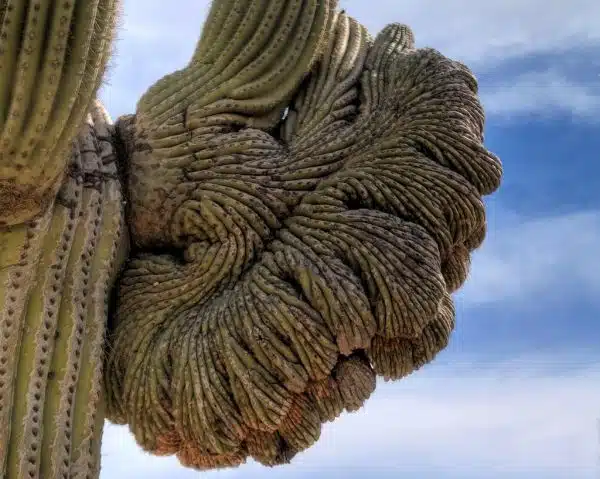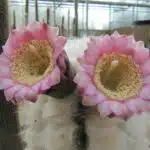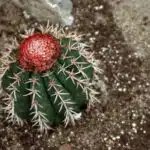Brain cactus, also known as Mammillaria elongata ‘Cristata’, is a unique and fascinating plant that has captured the attention of many horticulture enthusiasts. This cactus variety is recognizable for its distinct, brain-like shape, making it a popular addition to any indoor or outdoor garden. Its easy-to-care-for nature and striking appearance have made it a favorite among those looking to add character to their collection of plants.
In this article, we will be delving into the world of brain cacti, exploring everything from its origins and habitat to its growth patterns and care requirements. Whether you are a seasoned gardener looking to expand your collection or a beginner searching for an easy-to-grow plant, this guide will provide you with all the information you need to successfully cultivate and care for your own brain cactus. So, let’s dive in and discover what makes this unique plant so special!
What Is A Brain Cactus?
Brain cacti, also called Mammillaria Elongata Cristata, are a type of cactus that belongs to the Cactaceae family. The plant is native to Mexico, where it thrives in rocky outcrops and desert areas. These cacti are characterized by their unique shape that resembles the human brain. Their unusual appearance has made them one of the most sought-after indoor plants among collectors.
There are several types of brain cacti, including Mammillaria elongata crest, Mammillaria elongata f. cristata, and Mammillaria elongata ‘copper king.’ Each type has specific characteristics that make them unique from one another. The Mammillaria elongata crest is known for its compact size and round shape, while the Mammillaria elongata f. cristata has a more pronounced crested form with multiple ridges. The Mammillaria elongata ‘copper king’ has copper-colored spines that contrast beautifully against its green body.
Caring for brain cacti requires some knowledge on how to maintain their health and beauty. Brain cacti thrive in well-draining soil with adequate water drainage to prevent root rotting. They require bright but indirect sunlight and should be placed near windows facing east or west for optimal growth. Regular watering during summer months is recommended, while less watering is needed during the winter season when they enter dormancy mode. Applying fertilizer once every month can help promote healthy growth and flowering throughout the year.
With its unique appearance and easy-to-care-for nature, it’s no wonder why brain cacti have become so popular among plant enthusiasts worldwide. However, understanding their history and origins will enable you to appreciate these plants better and provide proper care tailored to their specific needs.
History And Origins Of Brain Cacti
As we delved into the previous section, it is evident that the Brain Cactus is a unique plant. Its bulbous appearance and intriguing texture are reminiscent of a human brain – hence its name. However, this plant goes beyond its physical attributes and has an underlying meaning that adds to its appeal.
Brain cactus symbolism dates back to ancient civilizations such as the Aztecs and Mayans. They believed that the plant embodied intelligence, knowledge, and wisdom. It was also considered a symbol of protection from evil spirits. This cultural significance is still prevalent today, with many people incorporating it in their homes as a decorative piece.
Here are four things you should know about Brain Cactus history:
- The scientific name for Brain Cactus is Mammillaria elongata.
- It is native to Central Mexico but can now be found worldwide.
- The plant belongs to the family Cactaceae and has over 300 species.
- Brain cacti have been cultivated for centuries due to their ornamental value.
What makes brain cacti unique? Let’s explore further in our subsequent section.
What Makes Brain Cacti Unique?
Brain cacti are fascinating plants that are known for their unique characteristics. One of the most interesting facts about these plants is their appearance. The plant gets its name from its resemblance to a human brain, with its numerous ridges and folds. This makes it an intriguing addition to any indoor garden or collection.
Another unique characteristic of brain cacti is their ability to store water in their thick stems. This allows them to survive in arid conditions where other plants would not be able to thrive. In fact, they are often found in rocky areas where the soil is poor and rainfall is scarce. They do well in bright light and can tolerate periods of drought, making them a low-maintenance choice for those looking for an easy-to-care-for plant.
Finally, brain cacti are also known for their slow-growing nature. It can take several years for them to reach maturity, but once they do, they can live for many years with proper care. Their unique growth patterns and striking appearance make them a popular choice among collectors and enthusiasts alike.
Overall, the unique characteristics and interesting facts about brain cacti make them a great addition to any indoor garden or collection. In the next section, we will explore some of the different varieties of brain cactus that you may come across when looking to add this fascinating plant to your home or office décor.
Varieties Of Brain Cactus
The unique characteristic of brain cacti lies in their appearance. The plant has a round, globular shape with tiny bumps that resemble a human brain. This distinctive look makes it an excellent conversation starter and a favorite among collectors. Brain cacti are also quite resilient and can thrive in harsh conditions, making them perfect for beginners.
There are several types of brain cactus, each with its unique characteristics. For example, the Mammillaria elongata or Lady Finger Cactus has elongated stems that give it the appearance of fingers. The Astrophytum asterias or Sand Dollar Cactus, on the other hand, has flat tops that resemble sand dollars. Other types include the Gymnocalycium mihanovichii or Moon Cactus and the Turbinicarpus valdezianus or Bishop’s Cap Cactus.
When choosing where to grow brain cacti, it’s important to consider their specific needs. These plants require well-draining soil and plenty of sunlight to thrive. They can be grown both indoors and outdoors but prefer temperatures between 60-85°F (15-29°C). When planted outdoors, they should be protected from extreme weather conditions such as frost and excess rain that may cause root rot. Indoor plants will need occasional fertilization to maintain their vibrant colors and healthy growth.
Where To Grow Brain Cacti
When it comes to growing brain cacti, one of the first things you need to consider is where to grow them. These cacti can be grown both indoors and outdoors, but different conditions may affect their growth and overall health. Indoor brain cacti typically thrive in bright areas with indirect sunlight, while outdoor ones can withstand more direct sunlight.
When deciding where to place your brain cactus, it’s important to note that they prefer well-draining soil and containers with ample drainage holes. This is because overwatering can cause root rot and damage the plant. For indoor cacti, terracotta pots or other porous materials are recommended as they allow for better airflow around the roots.
Outdoor brain cacti can also be grown in containers, but they will require larger pots or raised beds for optimal growth. The advantage of growing them outdoors is that they have access to natural light and air circulation, which can promote stronger stems and more vibrant blooms. Ultimately, whether you choose to grow your brain cactus indoors or outdoors will depend on your personal preferences and the environment you have available.
Moving forward into soil and watering requirements, proper care for your brain cactus involves understanding its unique needs when it comes to soil type and watering frequency.
Soil And Watering Requirements
Soil type is one of the key factors determining the health of a cactus plant. Generally, cactus plants prefer a soil mix composed of three parts potting soil and one part perlite or coarse sand. This soil should be well-draining and relatively nutrient-poor. Watering frequency is also important, cacti should be watered deeply and then allowed to almost completely dry out before being watered again. The optimum pH level for cactus is slightly acidic, ranging from 6.0 to 7.5. To ensure proper growth, pH should be tested once a month.
Soil Type
Having the best soil for your brain cactus is a fundamental factor in ensuring healthy growth and thriving of this plant. The brain cactus thrives well in well-drained soil that is rich in nutrients. Therefore, it’s paramount to ensure you select the best soil for your plant.
The best soil for your brain cactus should consist of a mixture of peat moss, sand, and perlite. This combination ensures that water drains quickly from the roots, preventing root rot. Before planting your brain cactus, ensure you prepare the soil by mixing these components thoroughly while removing any debris.
Soil preparation is essential as it provides an excellent foundation for healthy growth of the brain cactus. Ensure you utilize a container with drainage holes at the bottom to allow excess water to escape. It’s also necessary to provide adequate space between plants when planting them in pots to ensure proper air circulation around them. By following these steps, you’ll have provided the best possible environment for your brain cactus to thrive and grow healthily.
Watering Frequency
Transition:
Now that we’ve discussed the importance of having the best soil for your brain cactus, it’s time to consider another crucial factor in its growth and survival – watering frequency. Watering techniques play a vital role in ensuring your plant receives enough water without causing root rot or overhydration. In this subtopic, we will explore the watering requirements of the brain cactus.
Watering Frequency:
The brain cactus is known for its drought tolerance and can withstand long periods of dryness. However, like most plants, it still requires regular watering to grow healthily. It’s essential to monitor the soil moisture level regularly and water your plant when necessary. The frequency of watering depends on several factors such as light exposure, temperature, and humidity levels. Generally, you should water your brain cactus every two weeks during its active growing season, which is from spring to summer.
Drought Tolerance:
Due to its origin in arid regions with infrequent rainfall, the brain cactus has developed a unique ability to store water in its stem and leaves. This characteristic makes it an ideal plant for those looking for low-maintenance options or living in areas with limited access to water resources. However, it’s crucial not to assume that the plant is entirely self-sufficient and neglect watering altogether. Over time, lack of proper hydration may cause wilting or stunted growth of your brain cactus. In conclusion, to ensure healthy growth of your brain cactus, maintain a consistent watering schedule based on its specific needs while keeping an eye on the soil moisture level.
Water Ph
Transition:
As horticulture experts, we understand that proper plant care involves a combination of factors. We’ve already discussed the significance of soil quality and watering frequency for the growth and survival of your brain cactus. In this subtopic, we will delve into another crucial aspect of caring for your plant – water pH. Measuring acidity levels in water is essential in ensuring that your brain cactus remains healthy and thrives.
Measuring Acidity:
Water pH refers to the level of acidity or alkalinity in water on a scale from 0-14, with 7 being neutral. The ideal pH range for growing a brain cactus is between 6.0 to 7.5. If the pH level falls below this range, it may cause nutrient deficiencies or even toxicity in your plant, hindering its growth and development. To measure the pH level of your water source, you can use a digital meter or test kit available at most gardening stores.
Watering Frequency:
Besides measuring the pH level in water, watering frequency also plays a vital role in maintaining optimal conditions for your brain cactus’s growth. Overwatering or underwatering can affect soil acidity levels and cause root rot or dehydration respectively. Therefore, you should ensure that you water your plant consistently but not excessively during its active growing season based on its specific needs and environmental factors such as light exposure and temperature.
In conclusion, measuring acidity levels in water is crucial in maintaining optimal conditions for growing a healthy brain cactus. Water pH affects nutrient availability and solubility essential for plant growth; thus, it’s necessary to monitor closely. Additionally, ensure that you maintain an appropriate watering frequency to avoid overhydration or dehydration that may affect soil acidity levels negatively. With these tips in mind, you can enjoy watching your brain cactus thrive beautifully!
Light And Temperature Needs
Light and Temperature Needs:
The brain cactus, a unique plant with its striking appearance, requires specific environmental conditions to thrive. Proper lighting and temperature are crucial for the growth and development of this fascinating succulent. Think of the brain cactus as a sunbather, soaking up the warm sun rays to flourish. It needs bright light to maintain its beautiful shape and coloration. When grown indoors, place it near a south-facing window to ensure ample sunlight exposure. If you prefer outdoor cultivation, make sure that it is planted in an area where it receives at least six hours of direct sunlight per day.
The ideal temperature range for the brain cactus is between 60°F-80°F (15°C-27°C). This hardy plant can tolerate short periods of extreme temperatures but should not be exposed to prolonged cold or heat stress. If you live in a region where temperatures fall below 50°F (10°C), consider bringing your plant indoors during the winter months or providing additional insulation for outdoor plants. Moreover, avoid placing your brain cactus near heating vents, air conditioning units or drafty doors/windows as these can cause fluctuations in temperature that may harm the plant.
In summary, proper lighting and temperature are key factors in ensuring the optimal growth and health of your brain cactus. Whether grown indoors or outdoors, make sure that your plant receives bright light for several hours each day and is kept within an ideal temperature range. In the next section, we will discuss fertilizer and nutrient requirements necessary for maintaining this unique succulent’s healthy growth.
Fertilizer And Nutrient Requirements
Fertilizers are important for providing essential nutrients to plants, and vary depending on the type of plant and its needs. Different types of fertilizer contain different ratios and amounts of macronutrients like nitrogen, phosphorus, and potassium, as well as micronutrients like iron and zinc. Plants also have other nutrient requirements such as calcium, magnesium, boron, and molybdenum. Knowing which fertilizers and micronutrients are required by the specific type of plant is essential when deciding which fertilizer to use.
Fertilizer Types
Growing a brain cactus requires sufficient nutrients to ensure healthy growth and development. Choosing the right fertilizer is essential in providing the plant with the necessary nutrients it needs. When selecting a fertilizer, gardeners have two options: organic or synthetic. Organic fertilizers are made from natural materials like compost and manure while synthetic fertilizers are chemically manufactured. Both types of fertilizers can provide essential nutrients to the plant; however, each has its own advantages and disadvantages.
Organic fertilizers are an excellent choice for growing a brain cactus if you prefer using natural products in your garden. These types of fertilizers are slow-release, which means they gradually release nutrients into the soil over time, providing long-lasting benefits to the plant. Additionally, organic fertilizers help improve soil structure and fertility as they contain beneficial microorganisms that enhance soil health. One significant advantage of using organic fertilizer is that they are environmentally friendly and do not cause any harm to wildlife or pollute water sources.
On the other hand, synthetic fertilizers offer quick results, making them ideal for plants that need an immediate nutrient boost. They can also be formulated specifically for certain plants’ nutritional requirements and applied at different stages of growth throughout the season. However, these types of fertilizers contain chemicals that can harm beneficial organisms in soil ecosystems when overused or misused. Using too much synthetic fertilizer can also cause nutrient build-up in the soil leading to root burn or even death of your brain cactus. Therefore, it’s crucial to follow manufacturer instructions carefully when applying synthetic fertilizer.
In conclusion, choosing between organic or synthetic fertilizer depends on your gardening preferences and needs for your brain cactus plant care routine. Both types of fertilizers offer their unique benefits; therefore, gardeners must carefully consider which one suits their growing conditions best. Regardless of which type you choose, always follow seasonal application guidelines and use proper amounts to prevent any adverse effects on your brain cactus’s growth and development.
Nutrient Requirements
Hydroponic cultivation is a soil-less method of growing plants that involves the use of nutrient-rich water solutions. Brain cactus can be grown using hydroponics, which allows for better control over nutrient uptake and absorption. Nutrient requirements for brain cactus grown hydroponically are different from those grown in soil; therefore, it’s essential to select a fertilizer that meets the plant’s specific needs.
Organic fertilizers are an excellent option for hydroponic cultivation as they contain natural materials that can improve soil structure and health. However, when used in hydroponics, organic fertilizers must be carefully formulated to dissolve quickly and not clog irrigation systems. One of the significant benefits of organic fertilizers is that they contain beneficial microorganisms that enhance root development and nutrient uptake in plants. Gardeners who prefer using natural products in their hydroponic system should consider using organic fertilizers to provide their brain cactus with essential nutrients.
Nutrient requirements for brain cactus grown hydroponically vary depending on the plant’s stage of growth. During the vegetative phase, the plant requires higher levels of nitrogen to promote leaf growth and chlorophyll production. In contrast, during the flowering phase, potassium and phosphorus are necessary for flower development and fruiting. Therefore, gardeners should select a fertilizer that provides these essential macronutrients in balanced ratios based on their brain cactus’s current stage of growth. By providing adequate nutrients through proper fertilizer selection and application, gardeners can ensure healthy growth and development of their brain cactus in a hydroponic system.
Propagation Techniques
Fertilizer and nutrient requirements play a vital role in the growth and development of brain cactus. However, propagation techniques are equally significant to ensure the continuous growth of these plants. Water propagation is one of the most effective techniques for rooting brain cactus cuttings. This method involves placing the cuttings in a container filled with water until roots start to form. It is essential to ensure that the container is clean and free from any bacteria or fungi that may hinder root development.
Stem cutting is another common propagation technique used for brain cactus plants. This method involves cutting a healthy stem from the parent plant, allowing it to dry for a few days, then planting it into well-draining soil. The best time to take stem cuttings is during spring or summer when the plant is actively growing. It is important to allow the cuttings enough time to callus over before planting them in soil, as this helps prevent rotting.
Overall, propagating brain cactus can be an easy and rewarding experience with proper care and attention. However, it is important to note that different plants have different requirements for successful propagation; therefore, understanding each plant’s unique needs is critical. In the next section, we will discuss common pests and diseases that can affect brain cactus plants and how to identify and control them effectively.
Common Pests And Diseases
Just like how the human body is vulnerable to diseases and illnesses, plants are also susceptible to pests and diseases that can compromise their growth and overall health. Brain cacti are no exception to this rule. Despite being hardy plants, brain cacti can still fall victim to several types of pests, such as spider mites, mealybugs, and scale insects.
Preventing infestations is the best defense against pests. Regularly inspecting your brain cactus for signs of pests or diseases is crucial in keeping them at bay. Ensure that you keep your plant clean by removing any debris or dead leaves around it. Additionally, avoid overwatering your brain cactus as this can attract pests and lead to fungal infections.
Fungal infections can be detrimental to the health of your brain cactus if left untreated. Symptoms of fungal infections include wilting or yellowing of leaves, spotting or discoloration on the stem, and soft spots on the plant’s surface. Treating fungal infections involves identifying the source of the problem and taking appropriate measures such as adjusting watering habits or applying fungicides. By regularly monitoring your plant’s health and taking immediate action when necessary, you can prevent further damage caused by these pesky problems.
To maintain a healthy brain cactus, it is essential to conduct regular checks for signs of pests and diseases while maintaining proper watering habits. In addition to preventing infestations and treating fungal infections promptly, pruning your plant can also help keep it healthy. The next section will provide some useful tips on how to prune and maintain your brain cactus properly without damaging its structure or stunting its growth potential.
Pruning And Maintenance Tips
Proper pruning techniques are essential for maintaining the health and aesthetic appeal of your brain cactus. One of the most common mistakes when pruning is removing too much of the plant at once. Instead, it’s recommended to trim small sections at a time, ensuring that you’re not cutting away too much of the plant. It’s also important to use sharp, clean tools when pruning to prevent any damage or infection.
In addition to pruning, a regular maintenance schedule is crucial for keeping your brain cactus healthy. This includes watering the plant approximately once a week and providing adequate sunlight. However, be cautious not to overwater as this can lead to root rot. Additionally, monitoring the temperature and humidity levels around your cactus can help prevent any stress or damage.
To maintain optimal health and growth of your brain cactus, consider implementing these tips into your maintenance routine:
- Use well-draining soil specifically designed for cacti
- Fertilize with a balanced fertilizer every 2-3 months during growing season
- Rotate the plant regularly to ensure even growth and sun exposure
- Keep an eye out for any signs of pests or disease and address them promptly
As you continue caring for your brain cactus, be mindful of its growth patterns and adjust your maintenance routine accordingly. By following proper pruning techniques and a consistent maintenance schedule, you can enjoy a thriving brain cactus for years to come.
Transition: Now that you have mastered proper pruning techniques and maintenance routines, let’s dive into repotting your brain cactus.
Repotting Brain Cacti
After pruning and maintaining your brain cactus, it is important to ensure that it has enough space to grow. Repotting your plant is crucial in providing adequate room for its roots to spread out and absorb nutrients. According to recent studies, repotting your brain cactus every two years can increase its lifespan and improve its overall health.
Repotting techniques vary depending on the size of the plant and the type of soil you use. It is recommended to use well-draining soil, such as cactus mix or a combination of sand, perlite, and peat moss. When choosing containers, opt for ones with drainage holes to prevent waterlogging. A shallow container will also allow for better air circulation around the plant’s root system.
To repot your brain cactus, gently remove it from its current container by loosening the soil around the edges. Shake off any excess soil and inspect the roots for any signs of disease or rot. Trim away any damaged roots with sterilized pruning shears before placing the plant into its new container filled with fresh soil. Water thoroughly and wait a few days before exposing it to direct sunlight.
Repotting your brain cactus can be a simple process when done correctly. By providing enough space for growth and using well-draining soil in a suitable container, you can ensure that your plant will thrive for years to come. In the next section, we will explore creative ways to decorate with brain cacti in your home or office space.
Decorating With Brain Cacti
Once you’ve mastered the art of growing brain cacti, it’s time to explore creative arrangements and DIY projects that can transform your space into an oasis of green. These versatile plants are perfect for decorating any room in your home or office, as they require minimal care and add a touch of whimsy to any setting.
One popular way to showcase your brain cactus is by using them as centerpieces for special events such as weddings or dinner parties. Simply place a few potted cacti on each table, and add some colorful stones or sand around the base for a fun and festive look. Alternatively, you can create a desert-themed display by arranging multiple brain cacti together in a large planter, along with other succulents and rocks.
Another fun idea is to use brain cacti in DIY projects such as terrariums or wall art. With their unique shape and texture, these plants make great focal points in any project. You can also experiment with different types of containers, such as mason jars or glass bowls, to create a variety of looks. Whether you’re an experienced crafter or just starting out, there are endless possibilities when it comes to decorating with brain cacti.
- Create a mini desert landscape using sand, rocks, and brain cactus.
- Use brain cactus as part of a living wall installation.
- Incorporate multiple brain cacti into a succulent wreath for your front door.
- Make unique planters from recycled materials like old books or teacups.
- Add playful accents like miniature figurines or fairy lights to your brain cactus displays.
With so many options available, there’s no limit to what you can achieve when decorating with brain cacti. Whether you’re looking for a simple centerpiece or an elaborate DIY project, these quirky plants are sure to bring joy and inspiration to your space. In the next section, we’ll answer some of the most frequently asked questions about brain cacti to help you care for your plants and keep them looking their best.
Brain Cactus Faqs
Brain cacti are fascinating plants that attract gardeners and plant enthusiasts alike. However, like any other plant, brain cacti require proper care to thrive. One of the most common questions regarding brain cacti is how to propagate them. Brain cacti can be propagated by either stem cuttings or seeds. Stem cuttings taken during the growing season root easily and quickly. The cutting should be left to dry for a few days before planting it in well-draining soil.
Another frequently asked question is about common mistakes made while caring for brain cactus. Overwatering is one of the most common mistakes that gardeners make when caring for this plant. Brain cacti are adapted to arid environments and do not require frequent watering. They prefer soil that drains well and dries out between waterings. Another mistake is placing the plant in direct sunlight for extended periods, which can cause sunburned spots on the leaves.
In conclusion, it is essential to understand the basics of brain cactus care if you want your plant to thrive. Avoid overwatering and provide adequate light but avoid direct sunlight exposure for extended periods of time. Propagating brain cacti is simple and can be done with stem cuttings or seeds. With proper care, your brain cactus will reward you with its unique beauty for years to come!
Conclusion: The Beauty And Benefits Of Brain Cacti
One common question about brain cacti is whether they are easy to care for. The answer is yes, as long as you provide them with the right conditions. They thrive in bright, indirect sunlight and prefer well-draining soil. Overwatering can be detrimental to these plants, so it’s important to let the soil dry out completely between waterings. If you live in a humid climate, it’s best to avoid misting your brain cactus to prevent rot.
Aside from being low-maintenance, brain cacti also offer various benefits. For one, they are excellent air purifiers that can help improve indoor air quality by removing harmful toxins from the air. Additionally, their unique appearance makes them a popular choice for interior design. Whether displayed solo or as part of a collection of other succulents and cacti, brain cacti add an interesting texture and shape to any room.
Incorporating brain cacti into your home can have both aesthetic and health benefits. Their low-maintenance nature makes them a great option for those who want to incorporate plants into their space without having to devote too much time and effort into caring for them. Plus, their distinctive appearance adds visual interest and texture to any room they’re placed in. Overall, it’s clear that brain cacti make a wonderful addition to any home or office environment.
Conclusion
Brain cacti are a fascinating and unique addition to any plant collection. Originating from Mexico and Central America, these spiny succulents have gained popularity due to their distinct appearance and low maintenance requirements.
One of the most interesting features of brain cacti is their ability to survive in harsh environments with minimal water. They store water in their thick, fleshy stems and leaves, making them an ideal choice for those who want a low-maintenance plant that can withstand neglect.
Brain cacti come in a variety of shapes and sizes, from small pincushion-like specimens to larger globular forms. They can be grown indoors or outdoors, as long as they receive adequate sunlight and well-draining soil.
When it comes to decorating with brain cacti, they can be used as a striking focal point or as part of a collection of other succulents. Their unusual appearance adds interest and texture to any space.
In conclusion, brain cacti are a fascinating plant that can bring beauty and benefits to any home or garden. With their unique appearance, low maintenance requirements, and ability to thrive in harsh conditions, they are an excellent choice for both novice and experienced gardeners alike. Whether grown indoors or out, brain cacti are sure to add interest and personality to any space.
Image Credits
- “brain cactus” by bambe1964 (featured)





























